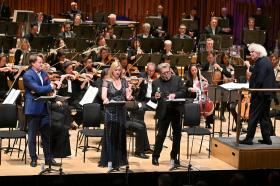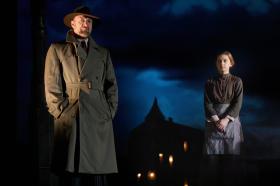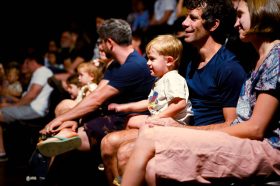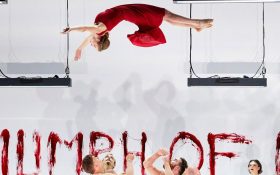If God died at the turn of the 20th century, by the start of the 21st it looked as though classical music was going much the same way. Audience figures were down and funding in short supply, while the average age of those attending live performances spiralled ever higher. In 2002, a report by the Policy Studies Institute into Cultural Trends found that young people ‘distrusted’ cultural institutions such as orchestras, which they perceived as too ‘authoritarian’, and warned starkly that unless the classical music world made a concerted effort to reach out to new audiences, the art-form would simply ‘fall away’.
Six years on, and the picture is rather different. Against all the odds, the first decade of the new millennium has seen a renaissance in the classical music world, with young artists like the trumpeter Alison Balsom, the Doric String Quartet, vocal ensemble Stile Antico and the composer Anna Meredith all making waves on the international scene. This side of the spotlights, audiences are looking younger and more diverse too. So what’s the secret? When did the tide turn for this neglected outpost of the contemporary art scene? How has classical music succeeded where God appeared to fail?
Funding has to be part of the answer. Despite a general downward trend in arts funding this century, thanks largely to the Olympics, classical music has emerged as something of a winner. Between 2003 and 2006, Arts Council grants in the classical arena rose by nearly a fifth, with an additional £1.3m being ploughed into hothouses for young talent, Aldeburgh, Dartington and the Sage Gateshead.
This investment is already paying off, with many of today’s young musicians having benefited either directly or indirectly from what these centres have to offer. For cellist Sally Woods, founder member of the International Baroque Players, an orchestra made up of twenty musicians under 30 and drawn from around the world, which had its inaugural concert this month in London, it was the experience of participating in the Aldeburgh Britten-Pears Baroque Orchestra Course that made the group possible.
“I would never have attempted something on this scale without it,” says Woods. “Nothing of this size within the Historical Performance field has been started by our generation. The experience we had as a group was the catalyst. We were bowled over by the standard of the orchestra on the course and decided that we could use it as the basis for a new, young, dynamic group.”
Yet, as the Millenium Dome goes to prove, funding on its own doesn’t automatically yield good results. In order to make projects work, artists must engage with the cultural climate in which they find themselves and hit on modes of expression that are both new and relevant to the audiences they seek.
For composer Anna Meredith, whose piece for 800 performers, ‘froms’, stole the show at the Last Night of the Proms, the secret lies in moving beyond traditional boundaries to embrace multiple genres of music and other arts. With one foot in both the classical and electronica camps, Meredith rejoices in putting previously separate styles and sound-worlds together. Among the projects she is working on is a Concerto for Beatboxer and Orchestra with vocal artist Shlomo.
“If work is more collaborative, it has more scope,” says Meredith. “The starting point is broader. There is a culture of open-mindedness at the moment and people are willing to experiment. For a while, composers tended to follow a similar path in terms of background and education. They were more academic. Now people are taking a starting point that is perhaps more irreverent, coming at it from popular music and dance music. There is space for disparate backgrounds.”
Across the board, this “culture of open-mindedness” is throwing up collaborations between artists from many different arenas, bringing classical performers to wider audiences than ever before. One of the most surprising of these partnerships is between rock star Sting and early music vocal ensemble Stile Antico, winners of the York Early Music Festival Young Artists Competition in 2005 and now considered to be one of the leading groups performing Renaissance polyphony.
“We haven’t strayed far from our core repertoire,” says Kate Ashby, one of the founder members. “However, recently, through a chance contact, we’ve been performing with Sting as part of his Dowland lute song project. It’s very interesting for us to see how someone from a completely different background interprets the music – further collaborations are in the pipeline.”
Yet it’s not just composers and performers who are branching out – venues too are becoming more adventurous in their programming. In Cambridge, Kettle’s Yard has engaged the Camberwell Composers’ Collective, of which Anna Meredith is a member, as their New Music Associates for 2009, putting them in charge of programming a series of concerts. Eclectic and adventurous in their tastes, the Collective looks forward to bringing a range of artists to the space.
“We’re programming some amazing traditional performers, some who play with homemade instruments, people who do impro and people who play standard repertoire. It should be a really exciting mix,” says Meredith.
In London, various club nights – most notably ‘NonClassical’ at the Macbeth in Hoxton and the ‘This Isn’t for You’ series in Shoreditch – make a feature of offering classical music and ‘genre-busting remixes’ with a view to presenting the art-form in ‘informal and relevant situations’.
More traditional venues, eager not to be left behind, are relaxing their conventions too, with the de rigueur silence and restrained rounds of applause giving way to informal chats and even the odd bit of audience participation. At vocal group The Shout’s excellent tenth anniversary concert at Kings Place last month, you could have been forgiven for thinking that you had wandered into a private soiree in someone’s sitting room, so casual and off-the-cuff was director Orlando Gough’s manner.
For Sally Woods and the other founders of the International Baroque Players, fostering this sense of informality and familiarity is the key to winning new disciples to the cause.
“We hope to break down many of the outdated barriers that are normally in place at most classical concerts,” says Woods. “We want to feel that our audiences get to know us as people and therefore learn more about the music that we play. We’ve been making use of Facebook as a publicity tool and have found this incredibly useful. Our aim is to put our enthusiasm for these extraordinary composers across to not just established concert-goers but also to the mainstream population.”
It certainly seems to be working. Even before playing their first concert, the International Baroque Players had already been approached for future work. With further concerts fixed in London and Oxford later this year, the group looks set to become a force to be reckoned with on the world music scene. All this in a matter of months.
Maybe God should take note…





